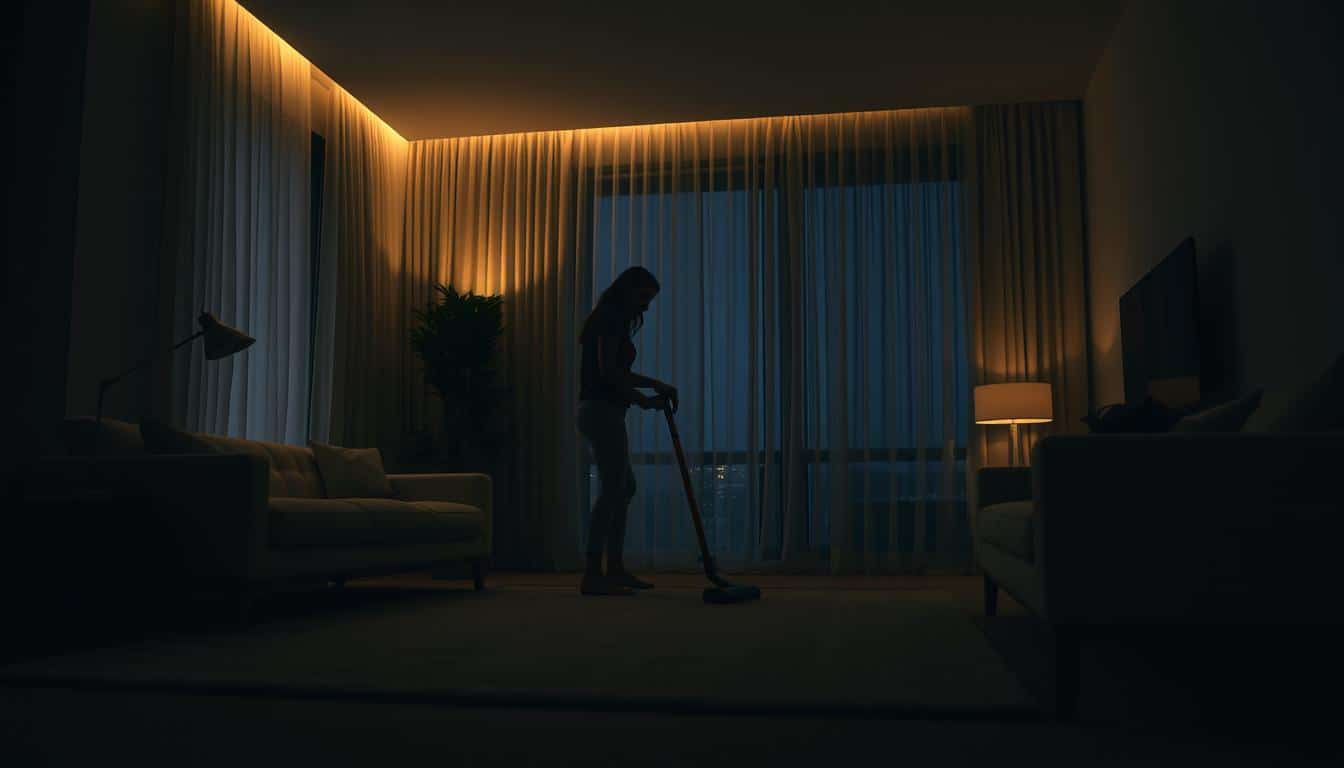In today’s world, keeping places like hospitals, hotels, and food services clean is crucial. The task becomes tougher at night, as it’s important to stop infections while letting people sleep peacefully. Take hospitals, for example, where 1 in 31 patients might get an infection any day. That shows why effective night shift cleaning is a must.
Old cleaning ways can be noisy, breaking the much-needed quiet of the night. That’s why using noiseless sanitation strategies matters. They help keep everything clean without waking up patients, guests, or staff.
We’ll look into some silent cleaning tips that keep hygiene top-notch around the clock. They also ensure everyone can rest easy. By learning and applying these methods, you can keep places spotless while causing minimal fuss.
Understanding the Challenges of Night Shift Cleaning
Night shift cleaning, especially in healthcare, needs a special approach. It’s crucial to keep places super clean while not disturbing patients. The main challenge at night is the noise from cleaning, which can mess with patients’ sleep and healing.
Working when it’s dark and feeling tired makes night cleaning harder. Not having sunlight messes with workers’ body clocks, making them less alert. Being exhausted can cause more mistakes, risking the cleaning quality and worker safety.
The mental toll of night shifts is big too. Not seeing daylight can make workers feel down or stressed. To help, it’s important to have good lighting and let workers take breaks. Using lights that feel like sunlight can make a big difference in their mood and work.
Importance of Noiseless Sanitation Strategies for Night Shifts
Making sure cleaning during night shifts is quiet is key to keeping peace. Paying close attention to silent sanitation helps avoid disturbing those sleeping in places like hospitals or hotels. It’s important for night shift cleaning plans to keep things quiet so everyone can sleep well.
Using quiet cleaning ways lets workers clean effectively without making too much noise. This method not only keeps places clean but also helps everyone rest better. Both the people living there and the workers benefit from noiseless cleaning practices. It shows how managing noise can boost everyone’s health and happiness.
Preparing Your Cleaning Schedule for Night Shifts
Making a good cleaning schedule for night shifts is key to handling tasks well. Night shifts face special problems like fewer staff and less resources. A right schedule can help solve these issues and make sure work is done completely.
Grouping tasks and giving each area a specific time slot makes things more efficient. This way, cleaners save time moving from one spot to another. It lets them focus better, making sure every area gets the attention it needs.
It’s smart to avoid busy areas when they’re most crowded. This keeps disruptions low and lets staff work freely. CleanLink says these methods really help keep things clean safely and effectively. Regularly checking what needs to be cleaned keeps the schedule working well.
It’s important to include breaks and extra time for any delays. This keeps the work doable and lets staff keep a good pace. Having a flexible schedule means you can handle surprises without messing up the work flow. This keeps everything clean while reducing bother for everyone in the building.
Essential Tools for Quiet Cleaning
Cleaning during night shifts needs tools that are both quiet and efficient. By choosing the right tools for quiet cleaning, you can make cleaning better while keeping things quiet for those sleeping nearby.
Key cleaning equipment for night shifts includes:
- Vacuum cleaners made to be quieter
- Microfiber cloths that clean well without noise
- Equipment that uses technology to lower noise
- Battery-operated tools to avoid loud power noises
- Silent, eco-friendly mops and brushes
Selecting effective cleaning tools not only makes cleaning easier but also helps the planet. It’s important to choose cleaning tools that are good for the earth. These tools should be made from sustainable materials and work quietly.
Creating a Quiet Cleaning Environment
Creating a peaceful cleaning setting is key for effective work at night. The aim is to cut down on noise but still clean well. Doing so requires simple but smart strategies.
To make cleaning quieter, use engineering tips. For example, slowing down machine parts can make them less noisy. Also, using bigger fans at slow speeds can keep things quiet.
Reducing noise in pipes and ducts helps too. Making sure flows are smooth is important. This lowers noise by cutting down on rough air flow.
Fixing machines with vibration isolators helps prevent noise. Making sure all parts are tight and not vibrating is key. It might mean adjusting loose bits and reducing shaking.
Anti-vibration connectors are great for controlling noise. They stop vibrations from reaching walls and ceilings. Also, keeping loud machines away from hard surfaces stops echoes.
Using soft materials in cleaning spaces is smart. Clothes and foam on surfaces can soak up sound. Making boxes around machinery can block a lot of noise too.
Putting up sound barriers can push noise away from work spots. These barriers work better when placed higher, near noise sources. In the end, making a quiet cleaning spot means being smart and strategic.
Using the Right Cleaning Products
Choosing the right cleaning products is key for effective cleaning and quiet nights. The right products make sure cleanliness doesn’t disrupt peace. Look for effective eco-friendly cleaners. They clean various surfaces well and keep things quiet.
Choosing Low-Noise Equipment
For night shifts, low-noise equipment is critical. Microfiber mops and dusters are quieter than vacuums. Think about getting quieter electric devices or those that run on batteries. These tools, along with the right cleaners, keep your cleaning effective and peaceful.
Opting for Eco-Friendly Cleaners
Eco-friendly cleaners are good for more than the planet. They usually smell less, making night cleaning more pleasant. Choosing these cleaners supports green goals and protects everyone’s health. When picking products for night shifts, go for those that are eco-friendly and meet your cleaning needs.
Mastering Effective Techniques for Silent Cleaning
To implement effective night cleaning practices, learning silent cleaning techniques is key. This can lower noise levels. One way is by cleaning in specific zones. It limits disruption and lets cleaners concentrate on one area before moving to the next.
Damp dusting is another quiet way to clean. It traps dust and dirt quietly. Using moist cloths also helps keep the air clean by stopping dust from spreading.
Using manual cleaning tools at night can make cleaning more effective. Tools like hand brooms and microfiber cloths are very quiet. They help keep the environment peaceful while cleaning thoroughly.
Being mindful while cleaning helps focus and avoid loud movements. A calm, careful way of cleaning makes for less noise and better results.
Communicating with Your Team During Night Shifts
Communicating well during night shifts is key for cleaning staff. It helps keep things quiet. Using hand signals, walkie-talkies, and set times for checking in helps reduce noise when teams need to talk. Hand signals let team members share important info without making a sound. This means they can keep cleaning without any disruptions.
Walkie-talkies are great for talking over long distances quickly. This lets staff work together better and solve problems fast. Being able to chat right away makes night cleaning go smoother. Having set times to check in helps too. It keeps everyone aware of where they are and what they’re doing. This reduces the chance of making noise by doing the same task twice.
Using these communication methods improves teamwork and cleaning at night. By focusing on quiet ways to talk, teams can do their work better. This keeps the area quiet for everyone in the building.

Maintaining Cleanliness Without Disruption
Keeping things clean without causing trouble is tricky, especially at night. By using smart plans, we can clean well and keep things quiet. This way, everyone’s sleep is safe while we keep the place tidy.
Cleaning in Stages
Cleaning one area at a time is a smart move. It lets workers do their job well with less noise. This way, people can sleep better, knowing their space remains calm and clean.
Establishing Quiet Zones
Setting up quiet zones helps protect sleep during clean-up. Workers know where they can be and where to be extra quiet. This keeps the cleaning smooth without any big sleep disruptions.
Maximizing Efficiency of Cleaning Staff
Getting the best out of cleaning staff on night shifts is key. An effective way to do this is through thorough training that focuses on teamwork and good talking. This approach helps everyone work better together, boosting how much cleaning they get done.
Setting clear schedules is also vital for a smooth-running night shift. When everyone knows what they’re supposed to do, working together gets easier. Software solutions help keep everything organized, making sure nothing is missed or messed up.
Talking openly with each other makes everything run more smoothly. Having regular meetings and allowing everyone to share thoughts can reveal issues and good ideas. This creates a trusting environment where everyone feels comfortable sharing their views and suggestions.
Adaptations for Specific Noisy Areas
Cleaning places like hospitals or hotels is tough. This is because they’re busy and need to be quiet. Workers must use quiet methods to keep everything clean and not disturb others. It’s all about being smart with how they clean.
Here are ways to clean without making a lot of noise:
- Use cleaning equipment that doesn’t make much sound.
- Clean when it’s less busy to avoid disturbing people.
- Use quiet cleaning tools like microfiber cloths and sprays that don’t make noise.
- Teach cleaning staff to move quietly and respect areas where guests are.
By using these methods, cleaning pros can do their job without making too much noise. This way, they keep places like hospitals and hotels clean and peaceful.
Conclusion
It’s key to use quiet cleaning methods at night to keep things clean without waking people up. By focusing on using low-noise tools and the right cleaners, companies can improve how they clean. These tips for night cleaning show how a careful approach lets us clean well without bothering others who need rest.
Teaching our staff about these quiet cleaning methods is very important. When we combine training with the right tools, our teams can overcome any challenges. This keeps places clean as per standard. Talking about keeping things quiet, it’s really about being smart and thoughtful. We need to make routines that both clean effectively and keep the peace for those sleeping nearby.



